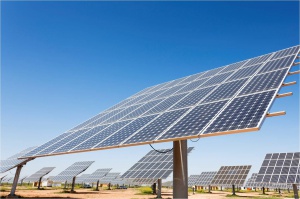
Application example: solar tracker (photovoltaic)
Solar power plants are essential to achieving the transition to renewable energy. A PV (photovoltaic) panel provides maximum yield when the sunlight strikes the panel at a normal angle (90 degrees).

An inclinometer directly measures the angle of the PV panel with reference to the direction of the gravitational force. Unlike indirect angular sensors, it requires no artificial reference, such as a magnet or laser beam, and can therefore be mounted virtually anywhere on a PV panel or synchronous group of PV panels. Moreover, it is not adversely affected by dynamic effects of the tracking movements, as these are extremely slow and small.
The inclinometer sends the measured angle of the PV panel to the control unit, which in turn instructs the motor to adjust the angle of the PV panel such that the panel is always perpendicular to the incoming rays of sunlight, according to a stored algorithm).
This results in optimum conversion efficiency from sunrise to sunset, increasing the yield by around 20% compared to fixed panel arrays. This significant boost in yield means the investment in solar tracking is quickly repaid.
Solar tracking generally entails mounting an array of PV panels on a mechanical rack, with a single inclinometer per array. Most solar tracking installations use a single axis solar tracker, which controls only the daily east-west movement. However, the yield can be maximized by using a dual axis tracker to adjust for the changing elevation of the sun during the seasons. By employing a dual axis inclinometer, the north-south tilt of the panels can also be measured and mechanically adjusted to keep the panels orientated normal to the sun, at every moment of daylight throughout the year.
Sensor:
- Single axis Inclination sensor QG30, with optional low pass filter
- Dual axis Inclination sensor QG40 or QG40N, with optional low pass filter
Specific:
- 1 or 2-axis ±90° (output 4-20mA / 0.5-4.5V)
More information
Would like to know more about this application or questions about another solution? Please contact your local distributor.
Latest news
- 23-02-2024DIS Sensors successfully renews its ISO 9001:2015 certification
- 17-01-2024Elevate Precision with DIS Sensors' Non-Contact Technology!
- 13-12-2023Best Wishes for a Merry Christmas and Happy New 2024 Year!
- 05-12-2023Agritechnica 2023 was a great success!
- 24-10-2023Agritechnica is just around the corner in Hannover
- 14-06-2023Visit us at iVT expo
- 01-06-2023Join Us at Apex 2023 - The 10th Anniversary Edition
- 08-11-2022New company video
- 14-09-2022Our office is closed on September 15th & 16th
- 15-07-2022New brochure
- 12-07-2022DIS professionalises the “casting process” of sensors
- 23-06-2022DIS Sensors in Soester Courant
Read more
Exhibitions
- 03-01-202430-06-2024
iVT Expo 2024 (DE) - 03-01-202430-06-2024
iVT Expo 2024 (Chicago, USA) - 03-01-202430-06-2024
ExpoAcero 2024 (Mexico) - 03-01-202412-05-2024
AISTech 2024 (Columbus, USA)
More exhibitions
Main menu
Contact
| DIS Sensors | |
| Oostergracht 40 | |
| 3763 LZ Soest | |
| Netherlands | |
| Telephone | |
| General: | +31 (0)35 603 81 81 |
| Technical | +31 (0)35 603 81 88 |
| General: | info@dis-sensors.com |
| Sales: | sales@dis-sensors.com |
| Technical: | support@dis-sensors.com |
| Co.reg.: | 31031359 |
| VAT: | NL008173278B01 |
| Privacy Statement | |
| Cookies | |
